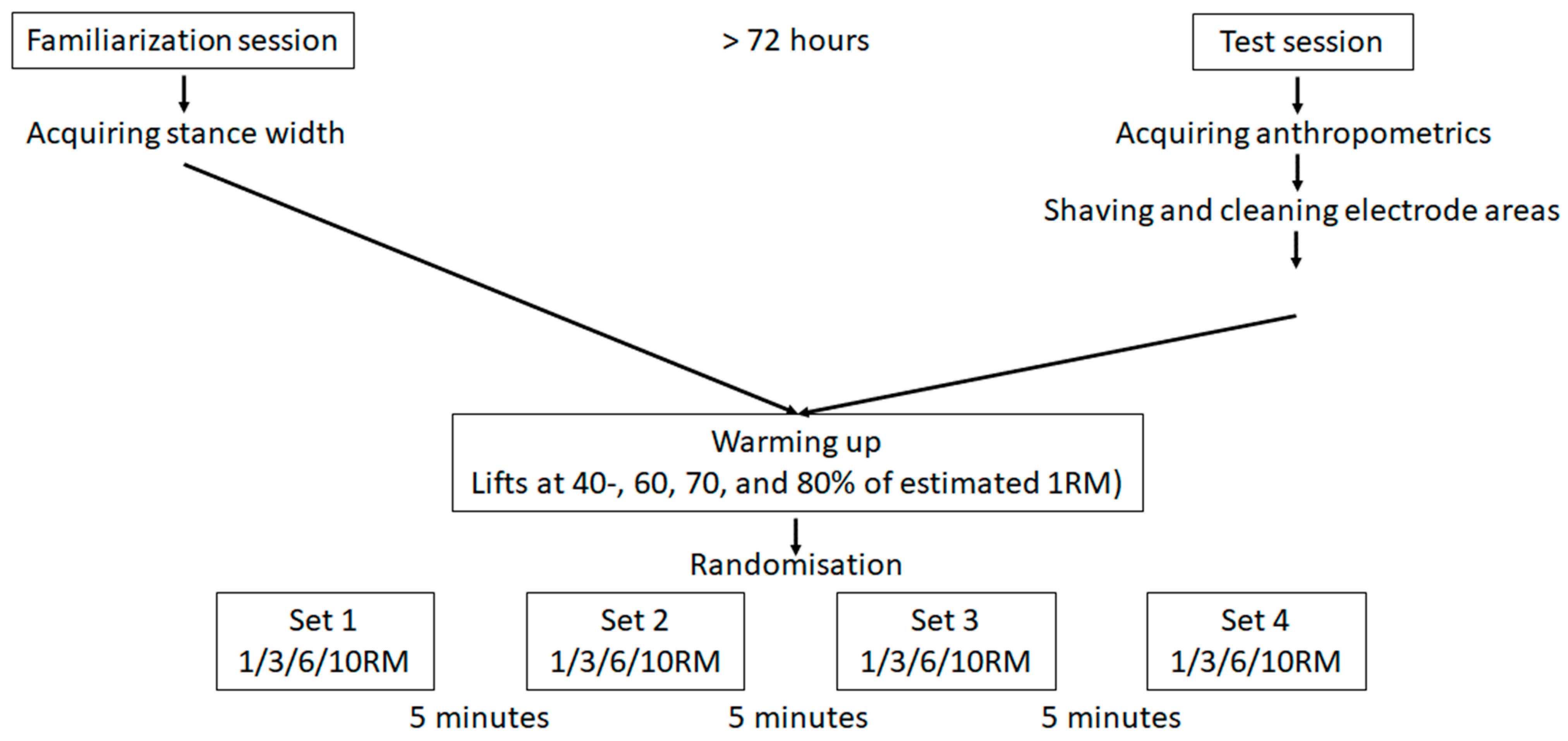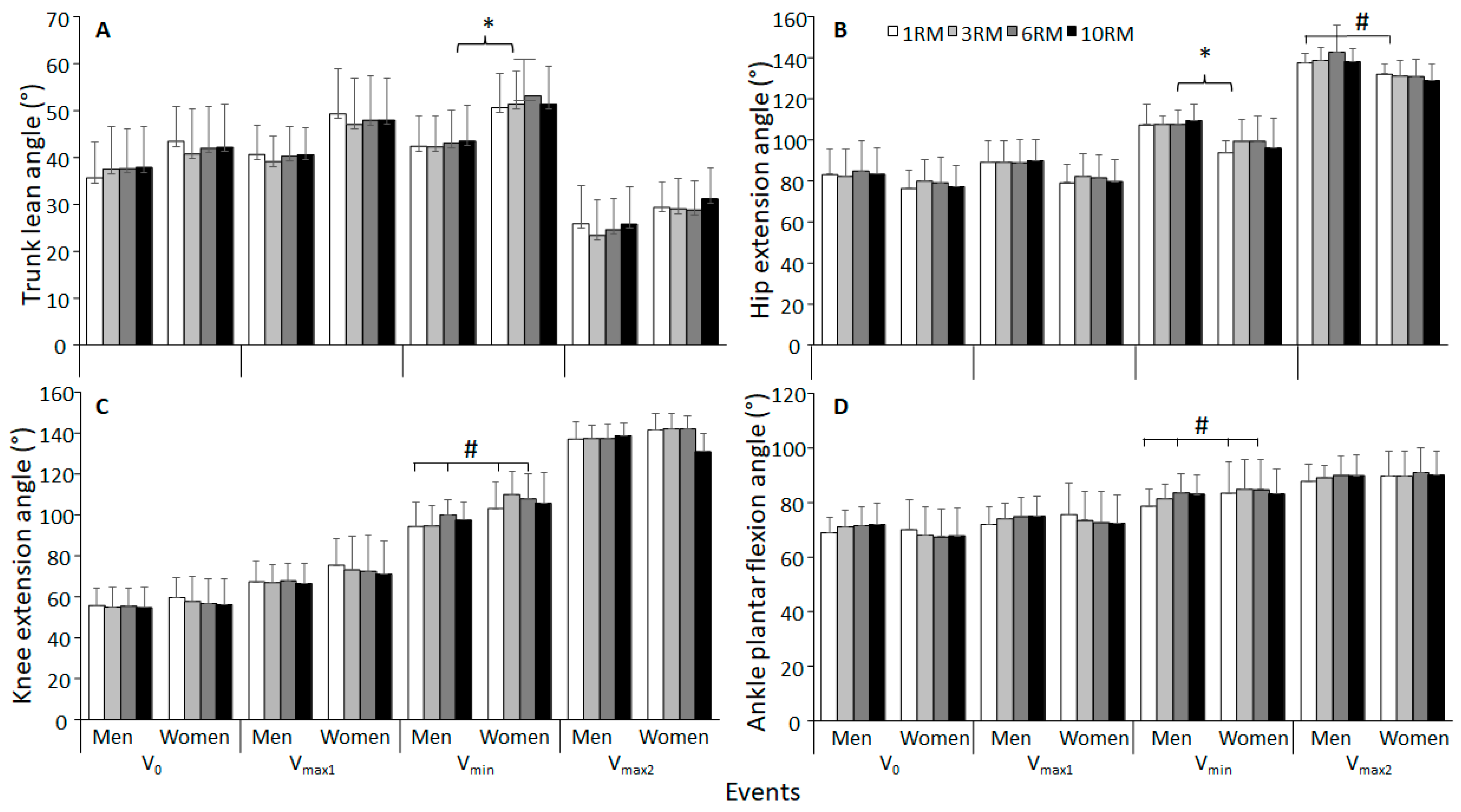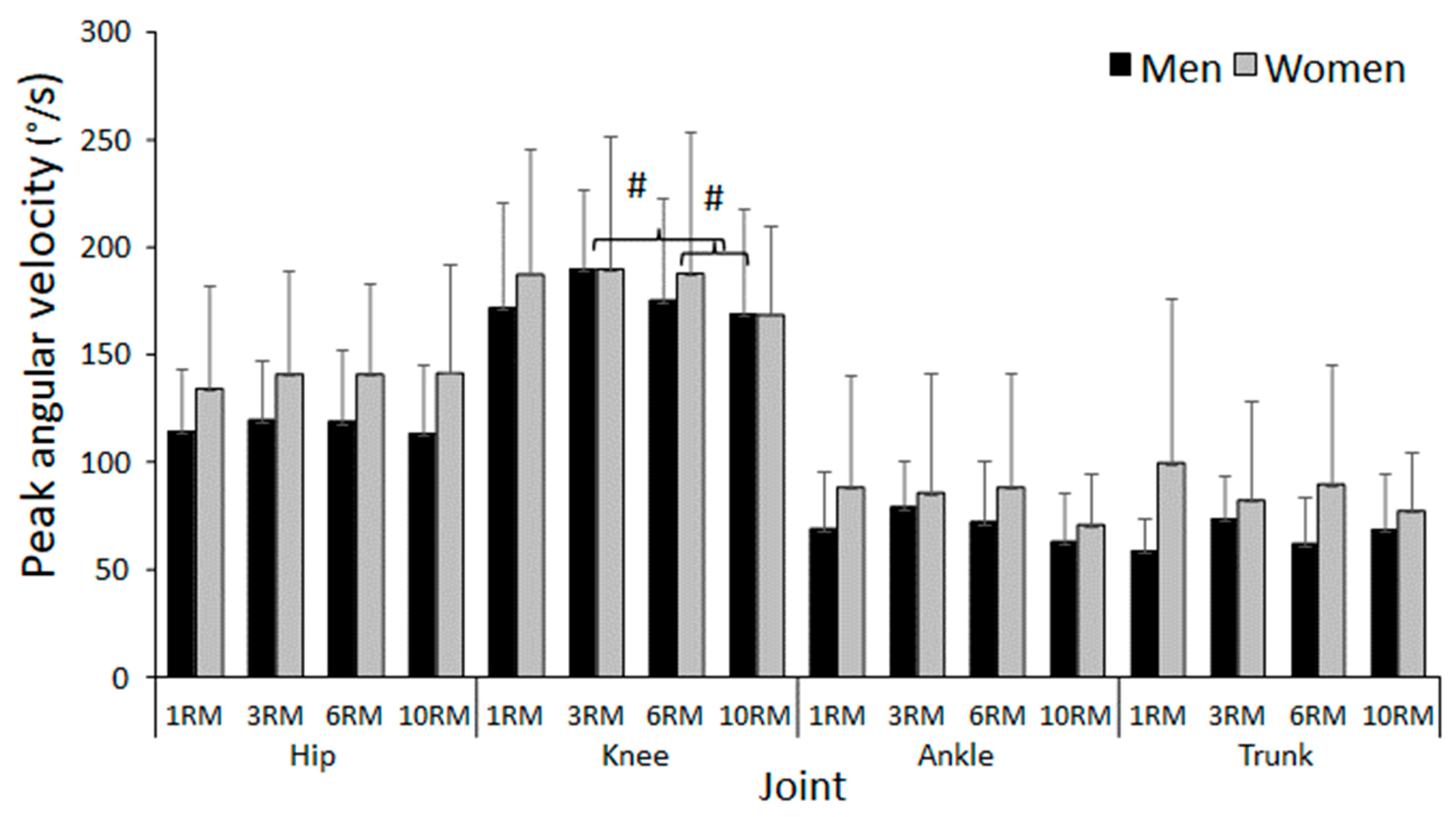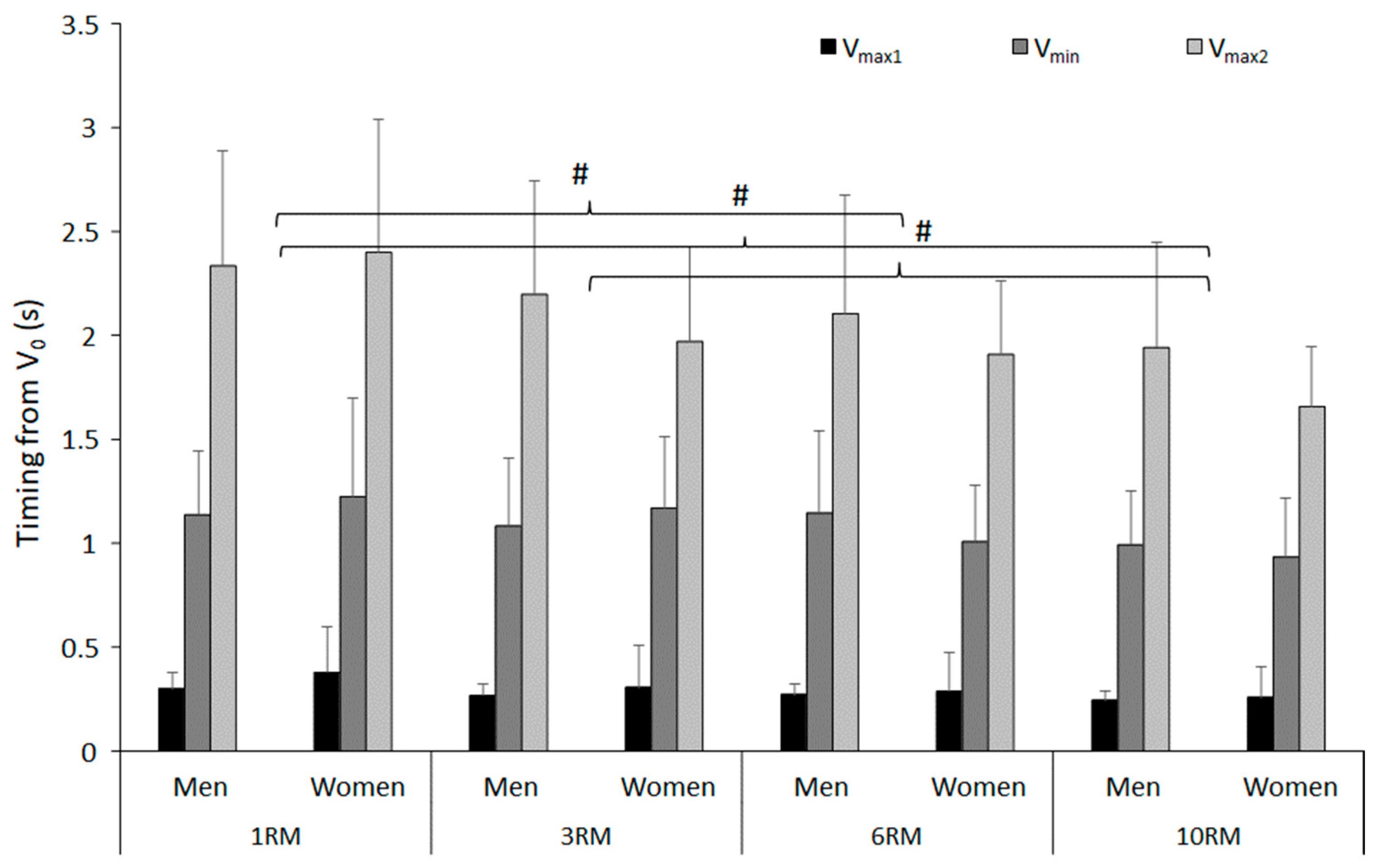The Effect of Sex and Different Repetition Maximums on Kinematics and Surface Electromyography in the Last Repetition of the Barbell Back Squat
Abstract
1. Introduction
2. Materials and Methods
2.1. Participants
2.2. Procedure
2.3. Statistical Analysis
3. Results
4. Discussion
5. Conclusions
Author Contributions
Funding
Institutional Review Board Statement
Informed Consent Statement
Data Availability Statement
Conflicts of Interest
References
- McKean, M.R.; Dunn, P.K.; Burkett, B.J. Quantifying the movement and the influence of load in the back squat exercise. J. Strength Cond. Res. 2010, 24, 1671–1679. [Google Scholar] [CrossRef] [PubMed]
- Escamilla, R.F.; Fleisig, G.; Lowry, T.M.; Barrentine, S.W.; Andrews, J.R. A three-dimensional biomechanical analysis of the squat during varying stance widths. Med. Sci. Sports Exerc. 2001, 33, 984–998. [Google Scholar] [CrossRef] [PubMed]
- Maddox, E.U.; Bennett, H.J. Effects of external load on sagittal and frontal plane lower extremity biomechanics during back squats. J. Biomech. Eng. 2021, 143, 051006. [Google Scholar] [CrossRef]
- Maddox, E.U.; Sievert, Z.A.; Bennett, H.J. Modified vector coding analysis of trunk and lower extremity kinematics during maximum and sub-maximum back squats. J. Biomech. 2020, 106, 109830. [Google Scholar] [CrossRef] [PubMed]
- van den Tillaar, R. Effect of descent velocity upon muscle activation and performance in two-legged free weight back squats. Sports 2019, 7, 15. [Google Scholar] [CrossRef]
- van den Tillaar, R.; Andersen, V.; Saeterbakken, A.H. The existence of a sticking region in free weight squats. J. Hum. Kinet. 2014, 42, 63–71. [Google Scholar] [CrossRef] [PubMed]
- Larsen, S.; Kristiansen, E.; van den Tillaar, R. New insights about the sticking region in back squats: An analysis of kinematics, kinetics, and myoelectric activity. Front. Sports Act. Living 2021, 3, 691459. [Google Scholar] [CrossRef] [PubMed]
- Myer, G.D.; Kushner, A.M.; Brent, J.L.; Schoenfeld, B.J.; Hugentobler, J.; Lloyd, R.S.; Vermeil, A.; Chu, D.A.; Harbin, J.; McGill, S.M. The back squat: A proposed assessment of functional deficits and technical factors that limit performance. Strength Cond. J. 2014, 36, 4. [Google Scholar] [CrossRef]
- Larsen, S.; Kristiansen, E.; Nygaard Falch, H.; Estifanos Haugen, M.; Fimland, M.S.; van den Tillaar, R. Effects of barbell load on kinematics, kinetics, and myoelectric activity in back squats. Sports Biomech. 2022; online ahead of print. [Google Scholar]
- Németh, G.; Ohlsén, H. In vivo moment arm lengths for hip extensor muscles at different angles of hip flexion. J. Biomech. 1985, 18, 129–140. [Google Scholar] [CrossRef]
- Visser, J.; Hoogkamer, J.; Bobbert, M.; Huijing, P. Length and moment arm of human leg muscles as a function of knee and hip-joint angles. Eur. J. Appl. Physiol. Occup. Physiol. 1990, 61, 453–460. [Google Scholar] [CrossRef]
- Stone, M.; Stone, M.; Lamont, H. Explosive exercise. Natl. Strength Cond. Assoc. J. 1993, 15, 7–15. [Google Scholar] [CrossRef]
- Schoenfeld, B.J.; Grgic, J.; Van Every, D.W.; Plotkin, D.L. Loading recommendations for muscle strength, hypertrophy, and local endurance: A re-examination of the repetition continuum. Sports 2021, 9, 32. [Google Scholar] [CrossRef] [PubMed]
- Larsen, S.; Haugen, M.; van den Tillaar, R. Comparison of kinematics and electromyographic activity in the last repetition during different repetition maximums in the bench press exercise. Int. J. Environ. Res. Public Health 2022, 19, 14238. [Google Scholar] [CrossRef] [PubMed]
- Kraemer, W.J.; Ratamess, N.A. Fundamentals of resistance training: Progression and exercise prescription. Med. Sci. Sports Exerc. 2004, 36, 674–688. [Google Scholar] [CrossRef] [PubMed]
- Gordon, T.; Thomas, C.K.; Munson, J.B.; Stein, R.B. The resilience of the size principle in the organization of motor unit properties in normal and reinnervated adult skeletal muscles. Can. J. Physiol. Pharmacol. 2004, 82, 645–661. [Google Scholar] [CrossRef] [PubMed]
- Miller, A.E.J.; MacDougall, J.; Tarnopolsky, M.; Sale, D. Gender differences in strength and muscle fiber characteristics. Eur. J. Appl. Physiol. Occup. Physiol. 1993, 66, 254–262. [Google Scholar] [CrossRef] [PubMed]
- Janssen, I.; Heymsfield, S.B.; Wang, Z.; Ross, R. Skeletal muscle mass and distribution in 468 men and women aged 18–88 yr. J. Appl. Physiol. 2000, 89, 81–88. [Google Scholar] [CrossRef] [PubMed]
- Monteiro, E.R.; Brown, A.F.; Bigio, L.; Palma, A.; dos Santos, L.G.; Cavanaugh, M.T.; Behm, D.G.; Corrêa Neto, V. Male relative muscle strength exceeds females for bench press and back squat. J. Exerc. Physiol. Online 2016, 19, 79–86. [Google Scholar]
- Häkkinen, K.; Kraemer, W.; Newton, R. Muscle activation and force production during bilateral and unilateral concentric and isometric contractions of the knee extensors in men and women at different ages. Electromyogr. Clin. Neurophysiol. 1997, 37, 131–142. [Google Scholar]
- Shultz, S.J.; Nguyen, A.-D.; Leonard, M.D.; Schmitz, R.J. Thigh strength and activation as predictors of knee biomechanics during a drop jump task. Med. Sci. Sports Exerc. 2009, 41, 857. [Google Scholar] [CrossRef]
- Pincivero, D.M.; Gandaio, C.B.; Ito, Y. Gender-specific knee extensor torque, flexor torque, and muscle fatigue responses during maximal effort contractions. Eur. J. Appl. Physiol. 2003, 89, 134–141. [Google Scholar] [CrossRef] [PubMed]
- Huston, L.J.; Wojtys, E.M. Neuromuscular performance characteristics in elite female athletes. Am. J. Sports Med. 1996, 24, 427–436. [Google Scholar] [CrossRef]
- Stearns, K.M.; Keim, R.G.; Powers, C.M. Influence of relative hip and knee extensor muscle strength on landing biomechanics. Med. Sci. Sports Exerc. 2013, 45, 935–941. [Google Scholar] [CrossRef]
- Claiborne, T.L.; Armstrong, C.W.; Gandhi, V.; Pincivero, D.M. Relationship between hip and knee strength and knee valgus during a single leg squat. J. Appl. Biomech. 2006, 22, 41–50. [Google Scholar] [CrossRef]
- Cahalan, T.; Johnson, M.; Liu, S.; Chao, E. Quantitative measurements of hip strength in different age groups. Clin. Orthop. Relat. Res. (1976–2007) 1989, 246, 136–145. [Google Scholar] [CrossRef]
- Hicks, A.L.; Kent-Braun, J.; Ditor, D.S. Sex differences in human skeletal muscle fatigue. Exerc. Sport Sci. Rev. 2001, 29, 109–112. [Google Scholar] [CrossRef]
- Maughan, R.; Harmon, M.; Leiper, J.; Sale, D.; Delman, A. Endurance capacity of untrained males and females in isometric and dynamic muscular contractions. Eur. J. Appl. Physiol. Occup. Physiol. 1986, 55, 395–400. [Google Scholar] [CrossRef] [PubMed]
- Cooke, D.M.; Haischer, M.H.; Carzoli, J.P.; Bazyler, C.D.; Johnson, T.K.; Varieur, R.; Zoeller, R.F.; Whitehurst, M.; Zourdos, M.C. Body mass and femur length are inversely related to repetitions performed in the back squat in well-trained lifters. J. Strength Cond. Res. 2019, 33, 890–895. [Google Scholar] [CrossRef] [PubMed]
- Nimphius, S.; McBride, J.M.; Rice, P.E.; Goodman-Capps, C.L.; Capps, C.R. Comparison of quadriceps and hamstring muscle activity during an isometric squat between strength-matched men and women. J. Sports Sci. Med. 2019, 18, 101. [Google Scholar]
- Hermens, H.J.; Freriks, B.; Disselhorst-Klug, C.; Rau, G. Development of recommendations for SEMG sensors and sensor placement procedures. J. Electromyogr. Kinesiol. 2000, 10, 361–374. [Google Scholar] [CrossRef]
- Cohen, J. Statistical Power Analysis for the Behavioral Sciences; Lawrence Erlbaum Associates: Hillsdale, NJ, USA, 1988. [Google Scholar]
- van den Tillaar, R.; Kristiansen, E.L.; Larsen, S. Is the Occurrence of the Sticking Region in Maximum Smith Machine Squats the Result of Diminishing Potentiation and Co-Contraction of the Prime Movers among Recreationally Resistance Trained Males? Int. J. Environ. Res. Public Health 2021, 18, 1366. [Google Scholar] [CrossRef] [PubMed]
- van den Tillaar, R. Kinematics and muscle activation around the sticking region in free-weight barbell back squats/kinematika in misicna aktivacija okrog obmocja prevelikega odpora pri pocepih z bremenom zadaj med dvigovanjem utezi. Kinesiol. Slov. 2015, 21, 15. [Google Scholar]
- Tesch, P.; Komi, P.; Jacobs, I.; Karlsson, J.; Viitasalo, J. Influence of lactate accumulation of EMG frequency spectrum during repeated concentric contractions. Acta Physiol. Scand. 1983, 119, 61–67. [Google Scholar] [CrossRef] [PubMed]
- Hooper, D.R.; Szivak, T.K.; Comstock, B.A.; Dunn-Lewis, C.; Apicella, J.M.; Kelly, N.A.; Creighton, B.C.; Flanagan, S.D.; Looney, D.P.; Volek, J.S. Effects of fatigue from resistance training on barbell back squat biomechanics. J. Strength Cond. Res. 2014, 28, 1127–1134. [Google Scholar] [CrossRef] [PubMed]
- Halperin, I.; Chapman, D.W.; Behm, D.G. Non-local muscle fatigue: Effects and possible mechanisms. Eur. J. Appl. Physiol. 2015, 115, 2031–2048. [Google Scholar] [CrossRef] [PubMed]
- Bryanton, M.A.; Kennedy, M.D.; Carey, J.P.; Chiu, L.Z. Effect of squat depth and barbell load on relative muscular effort in squatting. J. Strength Cond. Res. 2012, 26, 2820–2828. [Google Scholar] [CrossRef] [PubMed]
- Gorostiaga, E.M.; Navarro-Amezqueta, I.; Calbet, J.A.; Hellsten, Y.; Cusso, R.; Guerrero, M.; Granados, C.; Gonzalez-Izal, M.; Ibanez, J.; Izquierdo, M. Energy metabolism during repeated sets of leg press exercise leading to failure or not. PLoS ONE 2012, 7, e40621. [Google Scholar] [CrossRef]
- Bloomer, R.J.; Falvo, M.J.; Fry, A.C.; Schilling, B.K.; Smith, W.A.; Moore, C.A. Oxidative stress response in trained men following repeated squats or sprints. Med. Sci. Sports Exerc. 2006, 38, 1436–1442. [Google Scholar] [CrossRef]
- Baechle, T.R.; Earle, R.W. Essentials of Strength Training and Conditioning; Human kinetics: Champaign, IL, USA, 2008. [Google Scholar]






| Sex | Age (Years) | Height (cm) | Body Mass (kg) |
|---|---|---|---|
| Men | 23.6 ± 1.9 | 181.1 ± 6.5 | 82.2 ± 8.7 |
| Women | 23.9 ± 4.5 | 166.0 ± 4.5 | 63.6 ± 6.6 |
| Sex | 1RM (kg) | 3RM (kg) | 6RM (kg) | 10RM (kg) | Relative Strength |
|---|---|---|---|---|---|
| Men | 100.3 ± 26.9 | 90.2 ± 25.0 | 81.8 ± 22.4 | 74.4 ± 21.4 | 1.3 ± 0.2 |
| Women | 77.8 ± 11.9 | 69.1 ± 11.3 | 62.5 ± 8.2 | 56.6 ± 8.2 | 1.2 ± 0.1 |
Disclaimer/Publisher’s Note: The statements, opinions and data contained in all publications are solely those of the individual author(s) and contributor(s) and not of MDPI and/or the editor(s). MDPI and/or the editor(s) disclaim responsibility for any injury to people or property resulting from any ideas, methods, instructions or products referred to in the content. |
© 2024 by the authors. Licensee MDPI, Basel, Switzerland. This article is an open access article distributed under the terms and conditions of the Creative Commons Attribution (CC BY) license (https://creativecommons.org/licenses/by/4.0/).
Share and Cite
Hegdahl Gundersen, A.; Nygaard Falch, H.; Bao Fredriksen, A.; Tillaar, R.v.d. The Effect of Sex and Different Repetition Maximums on Kinematics and Surface Electromyography in the Last Repetition of the Barbell Back Squat. J. Funct. Morphol. Kinesiol. 2024, 9, 75. https://doi.org/10.3390/jfmk9020075
Hegdahl Gundersen A, Nygaard Falch H, Bao Fredriksen A, Tillaar Rvd. The Effect of Sex and Different Repetition Maximums on Kinematics and Surface Electromyography in the Last Repetition of the Barbell Back Squat. Journal of Functional Morphology and Kinesiology. 2024; 9(2):75. https://doi.org/10.3390/jfmk9020075
Chicago/Turabian StyleHegdahl Gundersen, Andreas, Hallvard Nygaard Falch, Andrea Bao Fredriksen, and Roland van den Tillaar. 2024. "The Effect of Sex and Different Repetition Maximums on Kinematics and Surface Electromyography in the Last Repetition of the Barbell Back Squat" Journal of Functional Morphology and Kinesiology 9, no. 2: 75. https://doi.org/10.3390/jfmk9020075
APA StyleHegdahl Gundersen, A., Nygaard Falch, H., Bao Fredriksen, A., & Tillaar, R. v. d. (2024). The Effect of Sex and Different Repetition Maximums on Kinematics and Surface Electromyography in the Last Repetition of the Barbell Back Squat. Journal of Functional Morphology and Kinesiology, 9(2), 75. https://doi.org/10.3390/jfmk9020075







